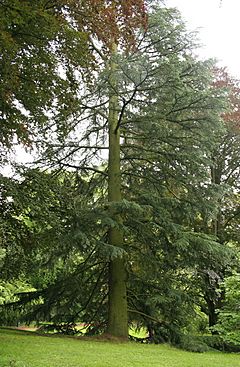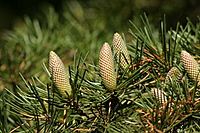Deodar cedar facts for kids
Quick facts for kids Deodar Cedar |
|
|---|---|
 |
|
| A young tree in cultivation | |
| Scientific classification | |
| Kingdom: | |
| Division: | |
| Class: | |
| Order: | |
| Family: | |
| Genus: | |
| Species: |
C. deodara
|
| Binomial name | |
| Cedrus deodara (Roxb.) G.Don
|
|
Cedrus deodara (Deodar Cedar, Himalayan Cedar, or Deodar; Hindi, Sanskrit: देवदार devadāru; Chinese: 雪松 xue song) is a species of cedar trees that live in the western Himalayas and in eastern Afghanistan, northern Pakistan, north-central India (Himachal Pradesh, Uttarakhand states), Kashmir, southwesternmost Tibet and western Nepal, and live in places at 1500–3200 m above sea level. It is a large evergreen coniferous tree reaching 40–50 m tall, exceptionally 60 m, with a trunk up to 3m thick. It has a cone-shaped crown with level branches and drooping branchlets.
The leaves are needle-like, mostly 2.5–5 cm long, occasionally up to 7 cm long, very thin (1 mm thick), borne singly on long shoots, and in dense clusters of 20-30 on short shoots; their colours range from bright green to glaucous blue-green in colour. The female cones are barrel-shaped, 7–13 cm long and 5–9 cm broad, and break when up mature (in 12 months) to release the winged seeds. The male cones are 4–6 cm long, and shed their pollen in autumn.
Cultivation and uses
It is widely grown as an ornamental tree, often planted in parks and large gardens for its drooping foliage. General cultivation is limited to areas with mild winters, with trees frequently killed by temperatures below about −25 °C (−13 °F), limiting it to USDA zone 7 and warmer for reliable growth. It can succeed in rather cool-summer climates, as in Stateline, Nevada, and Ushuaia, Argentina.
The most cold-tolerant trees originate in the northwest of the species' range in Kashmir and Paktia Province, Afghanistan. Selected cultivars from this region are hardy to USDA zone 7 or even zone 6, tolerating temperatures down to about −30 °C (−22 °F). Named cultivars from this region include 'Eisregen', 'Eiswinter', 'Karl Fuchs', 'Kashmir', 'Polar Winter', and 'Shalimar'. Of these, 'Eisregen', 'Eiswinter', 'Karl Fuchs', and 'Polar Winter' were selected in Germany from seed collected in Paktia; 'Kashmir' was a selection of the nursery trade, whereas 'Shalimar' originated from seeds collected in 1964 from Shalimar Gardens, India (in the Kashmir region) and propagated at the Arnold Arboretum.
This plant has gained the Royal Horticultural Society's Award of Garden Merit.
Construction material
Deodar is in great demand as building material because of its durability, rot-resistant character and fine, close grain, which is capable of taking a high polish. Its historical use to construct religious temples and in landscaping around temples is well recorded. Its rot-resistant character also makes it an ideal wood for constructing the well-known houseboats of Srinagar, Kashmir. In Pakistan and India, during the British colonial period, deodar wood was used extensively for construction of barracks, public buildings, bridges, canals and railway cars. Despite its durability, it is not a strong timber, and its brittle nature makes it unsuitable for delicate work where strength is required, such as chair-making.
Herbal Ayurveda
The use of C. deodara in Ayurvedic medicines is well recorded.
The inner wood is aromatic and used to make incense. Inner wood is distilled into essential oil. As insects avoid this tree, the essential oil is used as insect repellent on the feet of horses, cattle and camels. It also has antifungal properties and has some potential for control of fungal deterioration of spices during storage. The outer bark and stem are astringent.
Because of its antifungal and insect repellent properties, rooms made of Deodar (Cedrus deodara) wood are used to store meat and food grains like oats and wheat in Shimla, Kullu and Kinnaur district of Himachal Pradesh. In Himachal people suffering from asthma or other respiratory problems are advised to sit under a Deodar tree early in the morning.
Cedar oil is often used for its aromatic properties, especially in aromatherapy. It has a characteristic woody odour which may change somewhat in the course of drying out. The crude oils are often yellowish or darker in colour. Its applications cover soap perfumes, household sprays, floor polishes and insecticides and is also used in microscope work as a clearing oil.
Images for kids
See also
 In Spanish: Cedrus deodara para niños
In Spanish: Cedrus deodara para niños




